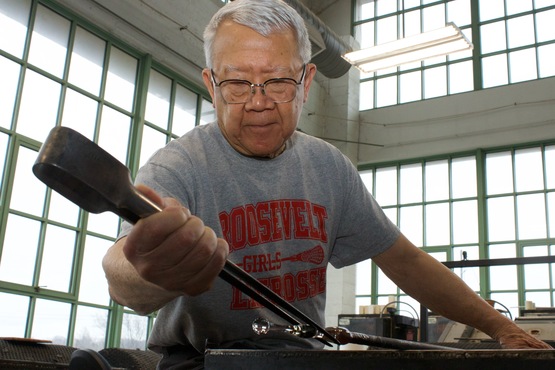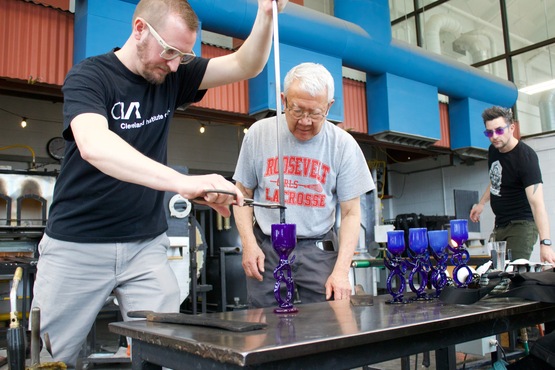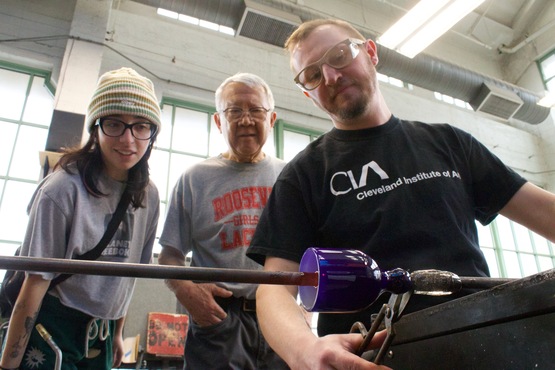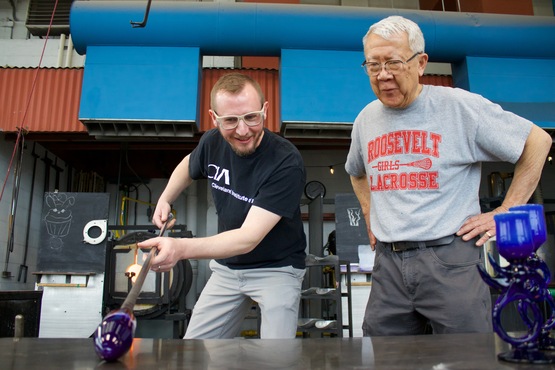
News . Feature Stories . 50 sparkling years
News
March 20, 2023
50 sparkling years
Glass program inspires passion, innovation, community and teamwork

CIA faculty member Benjamin Johnson trims the lip of a goblet while sophomore Annie O’Brien, Faculty Emeritus Brent Kee Young and studio manager Zachary Gorell observe his work in CIA’s Glass Studio.
By Karen Sandstrom
Call it kismet or even a series of fortunate events, but the origin story of Cleveland Institute of Art’s Glass program practically glistens with a sense of the inevitable.
It was 1971, and artist Dale Chihuly had just co-founded the Pilchuk Glass School in Stanwood, Washington. To gin up business, he invited members of the Union of Independent Colleges of Art to send two students to Pilchuk for a summer workshop.
Joseph Zeller was chair of CIA’s Ceramics program at the time. CIA had no Glass department then, but Zeller did have two ambitious and energetic Ceramics students: Christine Federighi ’72, and William Carlson ’73. At Pilchuk that summer, they were bitten by the glass bug. They called Zeller in the middle of one night with something of a demand.
“They told me that unless there was some kind of glass facility when they came back, they weren’t coming back,” Zeller says.
Without seeking permission from College leadership, Zeller quietly built a small glass furnace in the kiln room in Ceramics. It stayed hidden and dormant during the day. “Unless you were coming in at night, you never knew anything was going on,” Zeller says.
Before long, though, President Joseph McCullough caught wind and asked Zeller what was going on. When Zeller told him about the furnace, McCullough authorized him to turn a three-car garage on CIA’s property in University Circle into a glass studio. To this day, Zeller heaps credit on McCullough for his enthusiastic support.
“Joe was all about offering a full menu of opportunities at CIA,” Zeller says. “But I also think he liked glass. It’s so tactile and mesmerizing.”
McCullough’s support for the department never flagged. “He didn’t quite give us a blank check,” he adds, “but he never said no to a bill that crossed his desk.”
In 1973, the College hired Brent Kee Young, who had just earned his MFA at Alfred University in New York. From that point until his retirement from CIA in 2014, Young built the curriculum, found students to become new voices in studio glass, and established an undergraduate glass program to take seriously.
Federighi went onto a successful studio career in ceramics and was a professor at the University of Miami in Florida; she died in 2006. Carlson became a sculptor and glassmaker, and led departments at University of Illinois, Urbana-Champaign and the University of Miami.
This year, CIA’s Reinberger Gallery will mount the exhibition Risk + Discovery: Glass Innovation at CIA, from April 6 through June 16. The show will include work by Young, who handed department leadership to Marc Petrovic ’91 in 2014; by Benjamin Johnson, current chair of CIA’s Craft + Design Department and academic coordinator of Glass; and by other current and former faculty, technical specialists, alumni and students.
CIA Glass alumni have had their work collected by museums and sold in galleries around the world. They have forged careers in housewares and automotive work. Graduates have not just survived on glass, they have raised families, run businesses, earned awards and taught new generations.
Nate Cotterman ’07 makes contemporary glass barware, lighting and home decor items. He and his wife, Antonia Campanella ’10, run Nate Cotterman Glass in their home studio in Northeast Ohio. He credits CIA for giving him the problem-solving skills and lots of studio time to hone his craft. “It is truly a privilege to make a living creating work in a material I love,” he says. “It is awesome that I have been able to create a variety of lines of work that speak to my interest in industrial design, and that I can bring to life in glass.”
While none of the CIA artists have achieved household name status like Chihuly, many have enjoyed great success and made an impact in the glass world. “We’re all contributing and have our own identity,” Young says. “I’m proud of that.”
Building a legacy on teamwork
One memorable experience of Young’s tenure was the big move. In 1983, the College moved some departments out of its headquarters on East Boulevard and into “the Factory” on Euclid Avenue. Glass was among them. The whole department had to be moved during holiday break between ’82 and ’83. The task was enormous, but, Young says, “We didn’t think twice about it. And we were hot over there in a matter of a month.”
What got the job done so efficiently was teamwork. Young was purposeful about glassmaking as, in part, a process that took place in community. He assigned projects that required seasoned students to work with newbies. Studio cleaning was done as a group. As part of the school’s Craft Guild, students worked together to organize popular sales of their art. Glass students took (and still take) group field trips.
From such efforts, enduring relationships grew. Michael Mikula ’87 has been a full-time self-employed artist since 1988. Soon after graduation, he was invited to join Young and Mark Sudduth ’83 in their hot shop.
“Brent sought and succeeded at building a sense of community in the Glass Department,” Mikula says. “We took pride in our then-shiny new department, and enjoyed a genuine collegiality with deep friendships that have carried on ever since. A lot of changes have occurred at CIA since 1987, but I still feel at home there.”
That sense of community continues under Johnson, and it helped sustain Duanngamon “Liz” Duncan ’21 as she was learning to be an art student far from her family in Thailand.
Now pursuing her MFA at Ball State University in Muncie, Ind., Duncan remembers one especially difficult day when she was struggling with emotions. Her parents had left the U.S. to return to Thailand. She told Johnson she didn’t feel well and wanted to leave class.
“We talked about what needed to get done since I wasn’t going to be there. Then he left me alone—except he came back to ask me something,” Duncan says. “I was such a ball of negative emotions that I had to look up to the ceiling to stop myself from crying, so of course Ben noticed something was wrong.”
Duncan talked. Johnson listened. On that day, “Ben wasn’t only the instructor, and the program wasn’t just a way to get a job,” she says. “It was my community and support system. I saw Ben as a role model, really. He was one of the best parts of my experience as a Glass major.”
These days, Glass continues as part of the Craft + Design Department. The reorganization allows students to explore within craft disciplines while still focusing on their chosen medium.
Johnson, who joined CIA in 2018, has many of the same goals for his students that Young had during his tenure.
“I don’t tell students what they should make, how they should be, or what material they should use,” Johnson says. “I just try to get them to develop their own voice, so that they’re expressing themselves in some way with some material, and so that they have a studio practice that they can figure out how to sustain.”
Latest Headlines view all
-
April 24, 2024
Cleveland Institute of Art welcomes alum Omari Souza as 2024 Commencement speaker -
April 02, 2024
Cleveland Institute of Art students partner with Progressive Art Collection to exhibit Ready, Set, Relay! -
March 04, 2024
Cleveland Institute of Art announces Curlee Raven Holton Inclusion Scholar Program
Questions?
For more information about this or other CIA news, contact us here.










Social Feed